Now & New
- Explore
Under the Torii, Over the Water: Itsukushima Shrine’s Fleeting, Unusual State
Try to picture in your mind the start of the Reiwa era in Japan: the year was 2019, and to commemorate the ascension of a new emperor, most of the public was given an ultra-rare, ten-day-long Golden Week holiday from Saturday, the 27th of April, to Monday, the 6th of May. The people of Japan had plenty of reasons to be optimistic, for the Summer Olympics in Tokyo were slated for the year after, which would bring a tsunami of tourists to Japan and bolster the nation’s economy severalfold. Businesses and tourist sites all over Japan enacted major changes to entice these prospective international visitors, and it was in June of 2019 that the torii of Itsukushima Shrine on Miyajima was covered in scaffolding and underwent renovations. The renovation works were supposed to be timed with the Olympics and end sometime in 2020, but little did we know that a novel coronavirus would rear its head and make the entire world shut down in panic. That vermillion, floating torii that all of us went to Miyajima soon became all but a fleeting memory as the completion date was postponed time and again.

Sometime in 2021, a bridge connecting the island with the torii was erected to allow construction workers easier access to the site as refurbishment progressed. Then, in the fall and not a single moment too soon, the scaffolding finally came down, but the renovation works weren’t 100% finished just yet, as the bridge still remained. However, this awkward situation actually turned into a fortuitous, exclusive tourism opportunity as visitors could now walk on the bridge to approach the torii even at high tide without swimming or riding in a boat. The chance to see the torii from such an angle not on the ground, not on the water, but rather suspended above the water was a phenomenon so rare, one may argue that it only happens once in a lifetime. Since the bridge itself was projected to be dismantled by December, November was the window of opportunity I made sure not to miss.

Touring Itsukushima Shrine
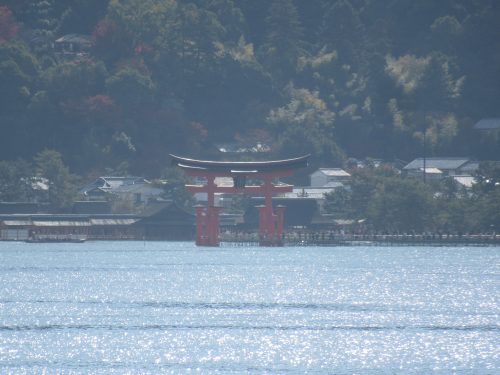
Ever since the scaffolding came down, the change in scenery is so apparent that the vermillion gate with people passing through it over the bridge is visible from the ferry (even from Miyajimaguchi Pier, if your camera’s zoom is powerful enough). Naturally, the first thing I did when we docked at Miyajima Pier was approach the shrine, ignoring the Omotesando shopping street that most tourists come to explore. There is a boatload of interesting photos of the torii that can be taken from a distance, the first one being the photo at the top of this article. In the plaza right outside the ferry terminal where the resident deer welcome tourists and try to sneak bites of their belongings, there is a diamond-shaped stone monument celebrating Itsukushima Shrine’s status of a UNESCO World Heritage Site. The viewer is meant to peer through the circular hole in the middle to catch a glimpse of Itsukushima Shrine’s torii smack dab in the center, as if spotting it on the horizon with a telescope. After snapping that shot, I hurriedly progressed to the next popular torii photo spot.
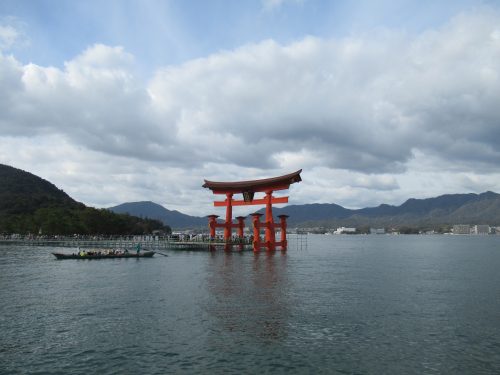
A moderate distance from the torii but not too far lies a rectangular stone embedded into the ground, almost like a stage meant for tourists to stand and take photos of the floating gate as well as photos of themselves with it. I seemed to have optimal timing as a boat was cruising past the torii right as I was doing my little photoshoot. Under normal circumstances, that boat could have sailed right through the vermillion gate, but in light of the recent renovations, it had to make due with going around these past few years. Obviously, the above situation is what goes on during high tide; during low tide, tourists can descend the stairs at this point and walk up to the base of the pillars to touch the torii like they have always been doing.
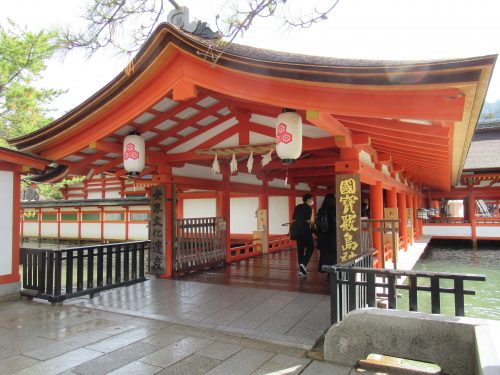
When I had enough of fooling around with my camera, it came time to check out the shrine’s main building, where almost all of the scaffolding has been taken down. The purification fountains at the entrance are still dismantled, and I predict they will remain unavailable until Japan lets its guard down completely regarding the novel coronavirus. Views of Miyajima’s surrounding scenery are always magnificent from inside the shrine, but thanks to the progress of renovations, the pictures I was able to take were a lot prettier than photos of the same place I took the summer before. The white tarps that previously covered the Marodo Shrine’s roof were out of the way, making the shrine blend in better with Senjokaku and the five-storied pagoda in the back, and the flooded shrine grounds enhanced the scenery further.
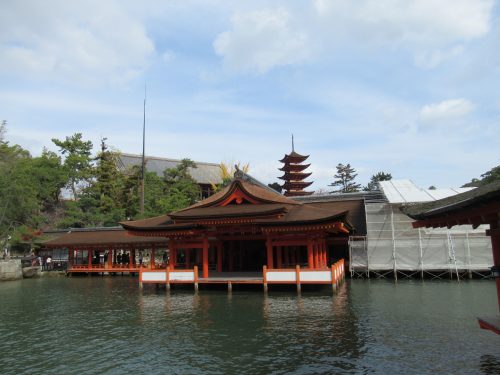
I walked farther along the boardwalk, past the stage to the lookout point where a bronze lantern stood and once signaled vessels during a bygone era. This lookout point was undoubtedly the best place to take a photo of the torii as it was facing the gate head on, and the sight of people looping through it while walking above water made the scene all the more magical. I was by far the only one with this idea as there was a queue of tourists lining up in front of the lantern, anxious to capture this seascape on camera. The queue moved faster than expected, though, and once at the front, I took my fair share of snapshots and briskly left the shrine.
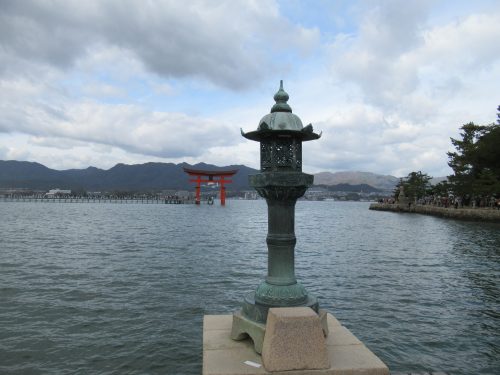
Experiencing the Restoration
As soon as I left the shrine grounds, I made haste for the line of people waiting to pass through the torii. Thankfully, everyone knew how to line up in an orderly fashion, and the queue progressed at a constant pace as tourists were herded through systematically. Do make sure you are actually in the line; you don’t want to be mistaken for someone who is simply passing through, waiting on a friend, or walking to the entry point to the bridge wondering, “why is everyone lined up?” While I was waiting, I took one step out to help recover somebody’s dropped item, and I almost lost my place in the queue! Since only so many people could fit on the bridge at once, they were letting us step onto the bridge in generously-sized groups, and my turn eventually came.
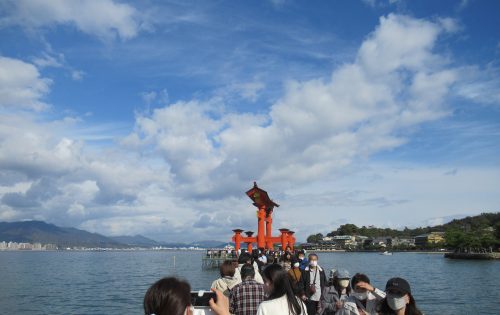
The situation on the bridge was orderly and chaotic at the same time. On one hand, there were two lanes of foot traffic so no one collided with anybody else, but on the other, there was no set pace at which we were told to walk, so people in front stopped all the time to whip out their cameras, cell phones, and other devices used to take pictures. When we got close to the torii, there was a man with a megaphone telling us not to black the way as we took pictures, and if at all possible, to take pictures while walking so the flow of traffic would not be disturbed. I scooched over to the outer rim of the path in order to snap a couple of photos, and then took a video of myself walking through the torii.
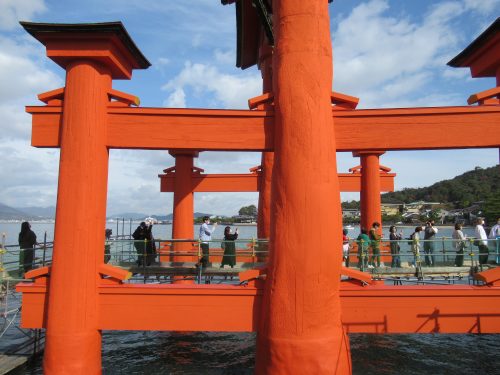
Right after walking through, I looked back and gazed up at the plaque at the top of the torii, contemplating how this might be the closest I ever get to the gate in terms of altitude. I then joined the constantly moving line back to dry land so the next batch could enter. On the white walls just outside the entry and exit corridor, there were signs illustrating the past renovation work on the torii as well as what the workers have been doing behind the scaffolding for the past couple of years. As expected, the pillars and other wooden parts of the gate hadn’t deteriorated that much since the last refurbishment, but the workers still had to check for damage and reinforce the structure before reapplying that iconic vermillion paint.
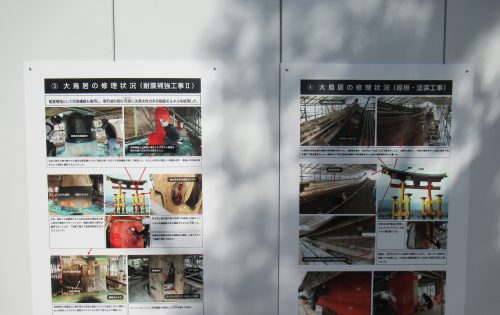
Taking Bites
By this time of day, my tummy was rumbling to the point where it couldn’t be ignored, so I stopped by my trusty local restaurant Mizuha (水羽) for what I hoped would be a brief lunch. How foolish I was to think that, considering the time of day and time of year: November is the hottest season to see the trees on Miyajima ignite in shades of red, orange and yellow, and twelve-something in the afternoon is when every tourist and his mother converges on the restaurants for a bite. I had to wait for a good long while before I was offered a table, but at least there were benches inside the restaurant that let me rest my weary, ravenous body. When I was seated at a table, I tried ordering as soon as I could, but the restaurant staff were so busy that even calling over a waitress was an ordeal that required a modicum of patience.
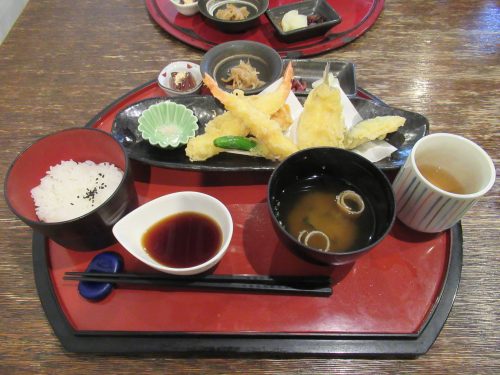
I wanted something that could be wolfed down quickly as I actually had work in the afternoon, so my choice that day was a tempura set meal. Besides the seafood and vegetable tempura and steamed rice topped with sesame seeds, there was also a cup of hot tea, a bowl of miso soup, some Japanese pickles, a side of shredded daikon radish, and one tiny piece of warabimochi for dessert. Given how antsy I was to eat, all that food disappeared in a flash, and despite the busy staff and my somewhat tight schedule, I decided to take a gamble and add on dessert to ensure a full belly before leaving the premises.
Moment of Joy: Time Well Spent
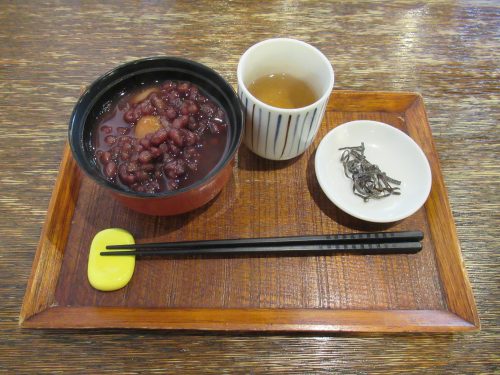
I gleaned over the menu once again and settled on a bowl of zenzai, a hot bowl of azuki bean soup with two big, gummy rice cakes inside paired with some sour, candied seaweed. The reason I am loyal to this restaurant is because I know everything I order off the menu will exceed my expectation, which is exactly what the zenzai did in terms of portion size and flavor. Every item here is worth any amount of wait, and I am especially willing to overlook said wait in the fall, when even weekdays have locals up to their eyeballs in work. In the end, I scarfed down this dessert lickety-split, made a break for the ferry, transferred to the streetcar, and slipped into work with ample time to spare and stories to tell.
Seeing Sights
Who goes to Miyajima in November and doesn’t see the autumn foliage? You are right to ask that question, and fret not, for I also obtained pictures that day of the maple leaves that inspired our ubiquitous momiji manju, the pride of Miyajima itself. Naturally, what better place to take such photos of the momiji (maple leaves) than at Momijidani Park? Truly, any tree in the park would have done, but I’m partial to this one because it features trees of multiple hues in one shot. If I had all day on this island, I would’ve explored the trails in more detail and perhaps even climbed to the top of Misen again if I were feeling it (I was still feeling a bit of burnout from climbing three times in March).
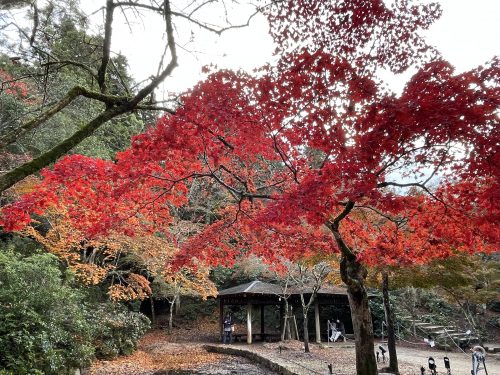
Of course, let’s not forget the deer, which can be found anywhere from the pier to the summit of Misen and everywhere in between. The ones farther away from town are less likely to snatch people’s things, and in fact may even be rather timid in front of humans. Although they aren’t a seasonal attraction like the fiery leaves surrounding them, the deer are a tourist attraction in and of themselves, and suffice it to say that a trip to Miyajima would be incomplete without interacting with them.

Though there is still more work to be done, Miyajima has seen astronomical aesthetic advancement this November, and it will only look better from next month onward when all the scaffolding disappears. I could’ve just waited until everything was the way it was before the renovations began, but being able to walk on that bridge going through the torii was a once-in-a-lifetime chance that I couldn’t pass up. With Japan’s borders having been open for a while and the torii getting a much-needed glow-up to match a new era, Miyajima is more prepared for international tourists than ever before, with its radiant, vermillion gate ready to show them the way!
Written by the Joy in Hiroshima Team
